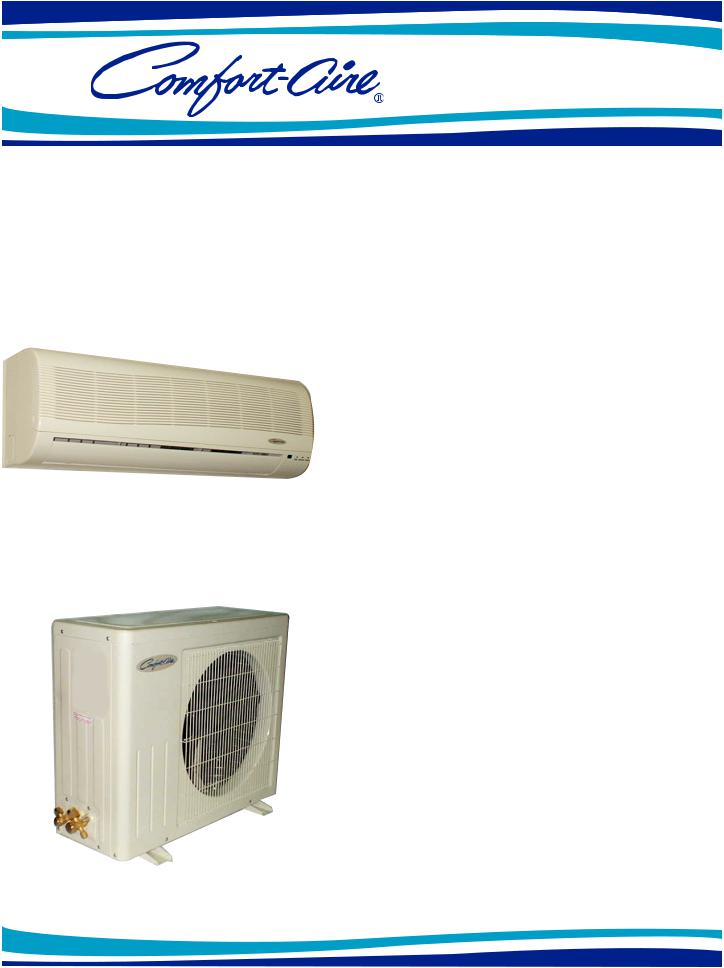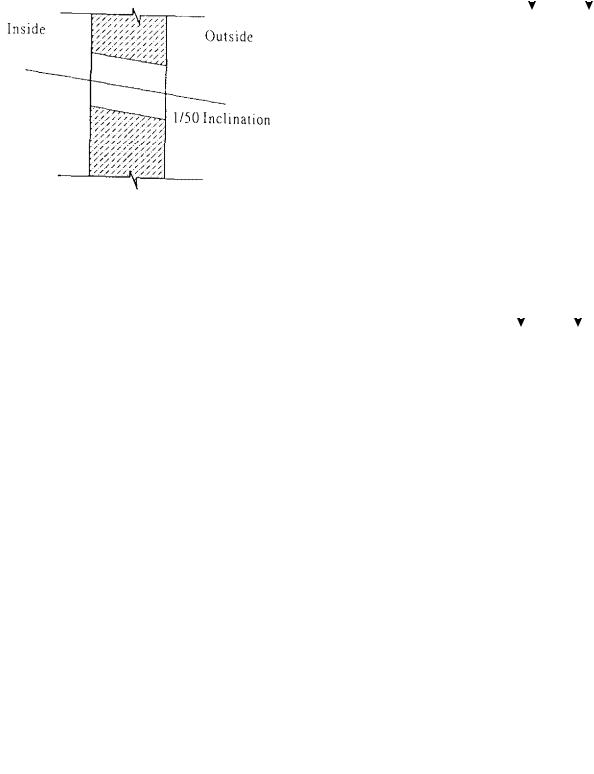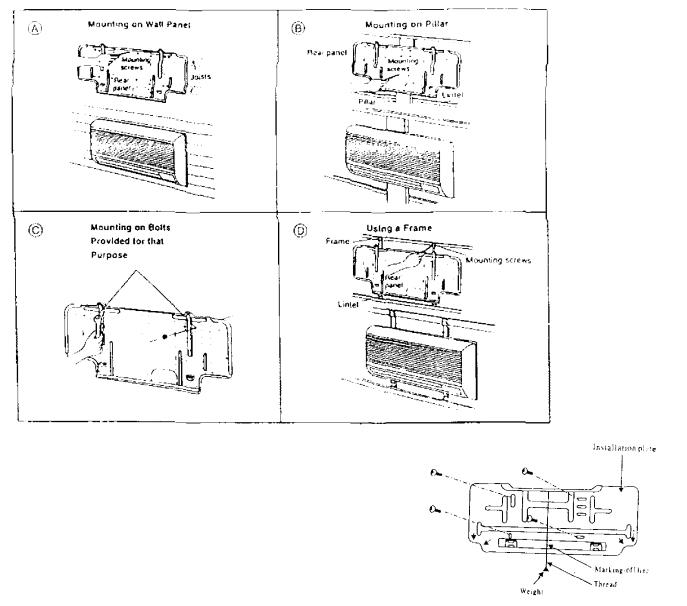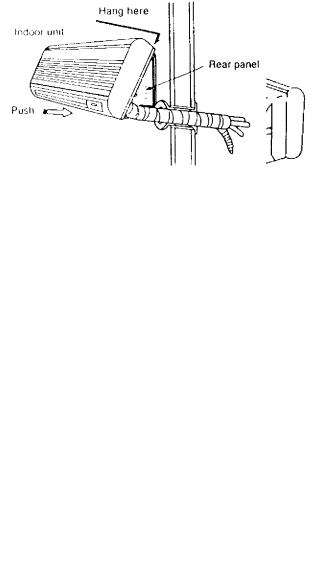Philips AMC S, AMC 25, AMC 30, AMW, AMC 45 User Manual
...
by AITONS'
Wall Mount Split Units
AMW/AMC 25, 30, 45 &60
AMW / AMC SERIES
Installation, Operation
And Maintenance Manual
Please read this manual before installing and operating the unit
CONTENTS
INSTALLATION INSTRUCTIONS
! Tools / Supplies
! Safety considerations
! Selection of location
! Recommended height and length
! Installation Method
! Refrigerant piping & drainage
! Electrical wiring
OPERATING INSTRUCTIONS
! Operating tips
! Product description
! Auxiliary control
! Remote control operation
! Operating instructions
! Care and maintenance
! Trouble shooting

INSTALLATION INSTRUCTIONS
TOOLS AND SUPPLIES
The following tools are needed |
The following materials are |
|||
for installation. |
required: |
|||
1. |
Level |
1. |
Correct size copper tubing |
|
2. |
Hole Saw |
2. |
Correct size drain pipe |
|
3. |
Core bits |
3. |
Sleeve and bush |
|
4. |
Hammer |
|||
4. |
Vinyl tape |
|||
5. |
Drill |
|||
6. |
Torque wrench |
5. |
Saddle & Clamps to support |
|
7. |
Adjustable wrench |
|
refrigerant piping |
|
8. |
Flat head screwdriver |
6. |
Power supply cable |
|
9. |
Philips head screwdriver |
|||
7. |
Insulation material |
|||
10. |
Wire stripper |
|||
11. |
Measuring tape |
8. |
Putty or similar sealant |
|
12.Ratchet set
13.Flaring tools
14.Tube cutter
SAFETY CONSIDERATIONS
Installation and servicing of air conditioner can be hazardous due to high refrigerant pressure and electrical components inside the unit. Only fully trained, qualified and certified service personnel should install, repair and service the air conditioner.
While working on the air conditioner, all precautions in the literature, tags and labels attached to the unit and all other general safety precautions should be carefully observed. Please follow all safety codes, wear safety glasses and work gloves. Also use quenching cloth for brazing operations.
It is highly recommended that this manual be read completely before installing and operating the system.
WARNING: The main power breakers to the unit , including its accessory or parts, should be turned off before performing service or maintenance operations on the unit. Dangerous high voltage can cause electric shock, serious personal injury or even death.

SELECTION OF LOCATION
Select a convenient location where:
INDOOR UNIT
!The cool air can reach every corner of the area to be cooled.
!The unit is away from any direct heat source
!Easy and short routing of the refrigerant and drain pipes to the exterior.
!There are no flammable gas, alkaline or acid present in the air.
!Air circulation is not obstructed, preventing good air circulation.
!The structure where the unit is installed should be strong enough to support the weight of the unit and also prevent any vibration during operation of the unit.
!Figure on the right shows the spacing to the nearest wall.
OUTDOOR UNIT:
!The condensing unit should be located as close as possible to the fan coil.
!The air inlet shall be located at least 4” from the wall or other obstruction for unrestricted airflow.
!The air outlet shall be located so as to direct discharged warm air away from the building. (Avoid low overhanging roofs to avoid re-circulation of condenser discharge air on vertical discharge models.)
!Mount the unit on a sturdy base.
!Figure on the right shows the spacing to be provided.

RECOMMENDED HEIGHT AND LENGTH
If the refrigerant piping is longer than the recommended length, or if the height difference between the indoor and outdoor unit is greater than recommended, the capacity will drop and the compressor could malfunction. Select an installation location that is within the recommended parameters.
(MAXIMUM PIPING LENGTH & HEIGHT RECOMMENDED)
|
|
Piping length |
(feet) |
|
50 |
Notes |
||
|
|
|
|
|
23 |
|
|
|
|
|
|
|
|
|
|
|
|
Cooling |
|
|
|
|
|
|
Installation |
Unit |
|
|
|
|
|
|
Piping |
||
capacity |
Add |
|
Not |
Needed |
|
not |
||
|
|
Diameter |
||||||
7,500 to |
charge |
|
needed |
(1) |
|
recom- |
1/4" and |
|
9,000 |
|
|
|
|
|
|
mended |
3/8” |
Btuh |
|
|
|
|
|
|
|
|
|
|
|
|
|
|
|
|
|
|
|
|
|
|
|
|
|
|
Recommended height difference is 23 ft or less *Evacuate refrigerant lines
(1)An installation with a piping length of 23 ft. or less is desirable. If this is not possible, the maximum piping length can be extended to 50 ft. by charging the system with additional refrigerant. However, cooling and heating capacity will be reduced.
INSTALLATION METHOD
HOLE DRILLING: After deciding the method your unit will be installed, a hole to route the connecting tubes and wires to the outdoor unit is to be drilled on the wall. The hole must be lower than the point where the drainpipe attaches to the drain pan of the unit. It should also be slightly declined towards the outside.
•Additional charge volume = (piping length - 23 ft.) x 0.2 oz.
|
|
Piping length (feet) |
|
|
Notes |
|||
|
|
|
33 |
55 |
||||
|
|
|
|
|
|
|
|
|
Cooling |
|
|
|
|
|
|
Installation |
Unit |
|
|
|
|
|
|
Piping |
||
capacity |
Add |
|
Not |
|
Needed |
|
not |
|
|
|
|
Diameter |
|||||
18,500 to |
charge |
|
needed |
|
(2) |
|
recom- |
|
36,000 |
|
|
|
|
|
|
mended |
|
Btuh |
|
|
|
|
|
|
|
|
|
|
|
|
|
|
|
|
|
Recommended height difference is 23 ft or less *Evacuate refrigerant lines
(2)An installation with a piping length of 33 ft. or less is desirable. If this is not possible, the maximum piping length can be extended to 55 ft. by charging the system with additional refrigerant. However, cooling and heating capacity will be reduced.
•Additional charge volume = (piping length - 33 ft.) x 0.2 oz.

MOUNTING INSTALLATION PLATE:
The fan coil can be installed using any of the four methods described below. Determine which is the most suitable method.
Position the installation plate on the wall making sure that it is parallel to the ground.
This can be done by aligning the markingoff line with a thread and weight as shown in figure on the right. This is to ensure that the condensate water does not overflow from the drain pan.
Mount the installation plate with the 4 screws provided. (If the unit is to be mounted on a concrete wall, consider using anchor bolts instead of the screws provided.

INSTALLATION OF FAN COIL:
The extended liquid and suction pipes and drain hose are hidden inside a slot at the back of the fan coil. This allows the hole on the wall to be either on the right or left side of the fan coil.
RIGHT SIDE HOLE POSITION: The piping and drain hose are routed straight through the hole.
LEFT SIDE HOLE POSITION: The piping and drain hose run from the right side to the left side of the unit, hidden in the slot at the back of the unit before routing through the hole on the left side of the unit.
MOUNTING FAN COIL UNIT:
Hook the fan coil onto the upper portion of the installation plate ensuring that it sits securely on the installation plate.
Press the lower portion of the unit against the installation plate until the hooks at the back of the unit are securely engaged with the installation plate.
MOUNTING CONDENSING UNIT:
Do not place the condensing unit directly on the ground. It should preferably be placed on a slightly raised platform to prevent rain water from splashing into it. Also ensure that it is level. Avoid installing the unit in places where flammable gases may be present.
beams or blocks
If necessary, due to the placement conditions, rubber cushions can be placed underneath the outdoor unit.

REFRIGERATION PIPING & DRAINAGE
PREPARATION OF PIPING
Fan coil and side discharge condensing units are equipped with flare connections. Improper flaring and brazing may cause refrigerant to leak out of the system. Follow these instructions carefully in preparing the refrigerant piping.
!Ensure that all piping is of the correct size.
!Measure the distance between the indoor and outdoor units' refrigerant connections, together with all the curves necessary. Add a few inches as slack.
!Lay the piping as straight as possible on a flat surface and with a pipe cutter, cut the piping according to the measured length.; Do not tighten the cutter excessively during cutting as this may cause the pipe to deform. Do not use hacksaw or similar tools to cut the pipe, as it results in metal shavings getting inside the pipe. This also makes proper flaring impossible.
!Use a reamer to remove burrs from cut edges. Hold the pipe ends upside down to prevent metal powder from getting into the pipe.
Pipe
Reamer
Note:
As the pipe is round, cutting should be |
Pipe cutter |
performed on a straight section. Also, |
|
do not apply too much force with the |
|
blade of the pipe cutter. |
|
Keep pipe facing downward when removing burrs.
!For connection to flare settings, the pipe has to be flared. Remove the flare nut from the unit and insert it onto the piping.
!Fit the pipe into the bar of the flare tool, about 0.5 mm higher than the surface of the bar.
!Center the flare punch carefully on the pipe and turn gradually to widen the pipe. Check the finish of the flare to ensure even flaring.
!Cover the flared ends with tape to prevent dust from entering.
|
Handle |
|
Flaring tool |
|
Flaring bar |
|
Length of periphery portion |
Flare nut |
L should be constant |
|
|
0.635 (1/4”) only |
0.952 (3/8”) and larger |
Approx. 1 mm
0.5 mm

PIPING INSULATION
Liquid and suction lines must be insulated separately. In a cooling only type air conditioner, both pipes become cold during operation. This can cause moisture to condense on the surface of the pipes, resulting in heat loss.
Insulation
Narrow Pipe
Wide Pipe
Common insulation
Separate insulation is essential
PRECAUTIONS WHEN BENDING PIPES
!The air conditioner's performance will suffer if the piping is crushed.
!Bend pipes using the pads of your thumbs to prevent them from collapsing (See picture on the right.)
!Use a pipe bending tool to bend pipe wider than 1/2" in diameter.
Bend with pads of thumbs
Pipe bending tool
b/a = 0.7 or more
FLARE FITTING CONNECTION. There are 3 piping rules:
(a) DRY: Never allow any water to get |
(b) CLEAN: Never allow dirt, sand or other |
inside the piping. |
foreign particles to get inside the piping. |
Cap
Cap
Keep cap attached until immediately before making piping connections.
Keep cap attached until immediately before making piping connections.
